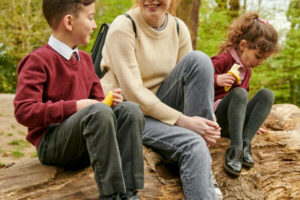Childcare is an essential service for many families, but like any human activity, it can also have a significant impact on the environment. With global carbon emissions on the rise, it’s important to consider the carbon footprint of different forms of childcare, such as nurseries and childminders. In this blog post, we outline why childminding is the lowest carbon form of childcare, and in particular significantly lower-carbon than its big ‘competitor’, nursery.
1. Childminders use building stock more efficiently
According to The Climate Change Committee (CCC), buildings contribute 23% to carbon emissions in the UK. Childminding, however, is substantially more efficient in building use than nurseries. Nurseries usually use commercial properties, which require significant energy and resources to build and maintain. On the other hand, childminders use their own homes as a setting, which eliminates the need for additional commercial property. This means that childminders avoid the 6600 kg of carbon that would have been generated from the construction and other lifetime building costs of a nursery.
Here’s the detail on that number: Buildings contribute between 30-40% of global carbon emissions, with embodied carbon (the carbon footprint of building materials and construction) accounting for 11% of global CO2 emissions. On average, embodied carbon amounts to 600 kg of CO2 per square metre throughout the lifetime of a building. A typical nursery uses 4.4 square metres of space per child. It takes over 50 tonnes of CO2 to build an average UK house, and every square metre built in residential construction accounts for 441 Kg of CO2 eq. With the average size of nursery settings being 47 places, the carbon footprint of a single nursery can be significant. In fact, nurseries produce 2640 kg carbon per child place created. Consequently, the average childminder – with 2.5 children in their setting – averts 6600 kg CO2 per childminder.
2. Childminders can use their houses even more efficiently
In addition to using existing housing estate, childminders can further reduce their carbon footprint by spending plenty of time outdoors – and being mindful of their energy usage when they are at home. By making simple changes, such as turning off lights when not in use, setting the thermostat to a lower temperature, and unplugging electronics when not in use, childminders can significantly cut down on their carbon usage.
A conservative estimate of the average amount of CO2 that can be averted by using energy efficiently is 405kg per year per childminder. This is calculated using the average carbon footprint per household in the UK, which is 8.1 tonnes of CO2 per year. Childminders have on average 2.5 children per setting, and by spending plenty of time outdoors and also implementing energy-saving measures, we estimate that 5% of the average CO2 production can be averted. This is highly conservative — according to a survey of 80 studies, there is a global potential to reduce approximately 29% of the projected baseline emissions by 2020 in these sectors.
3. More Hyper-local Care in London Saves on Transport Costs
Childminders have another advantage over nurseries in that they can deliver care more locally. In fact, there are almost three times as many childminders in London as there are nurseries, which means that they are considerably closer to families. This proximity means that families have to travel less to reach them, reducing their carbon footprint.
Situating care more hyper-locally saves 30-40 kg CO2 per setting per year in transport costs in London alone (likely far more outside London). This is because childminders can offer their services within walking or cycling distance from the families they serve, reducing the need for transportation.
The detail on that number: Transport has the highest reliance on fossil fuels of any sector and accounted for 37% of CO2 emissions from end-use sectors in 2021. Travelling 7,500 miles per year, a car produces 2 tonnes of CO2. In London, 68% of households with children have access to at least one car. We estimate that childminders can avert 43kg of CO2 per year by reducing the amount of car transport needed. This estimate is based on the assumption that each childminder averts 3 miles of car travel across all the children they look after, an average travel time to a childminder of 15 minutes and a CO2 cost per mile of car travel of 0.27.
4. Childminders can use the Circular Economy for Toys and Furniture
Another way that Koru Kids childminders are reducing their carbon footprint is by participating in the circular economy. The circular economy is an established and respected way to combat climate change. It involves keeping resources in use for as long as possible, extracting the maximum value from them, and then recovering and regenerating them at the end of their life.
By participating in a ‘circular economy’ for toys and furniture, childminders can reduce their carbon emissions even further. Childminders are encouraged, trained, and supported to recycle toys and furniture. Through our training program, childminders learn about a circular economy approach to toys and furniture, using second-hand items and reducing the need for new products.
We estimate that using the circular economy in this way averts 630kg CO2 per childminder. This is calculated by estimating that each childminder purchases 30 toys per year, with an average plastic weight of 2kg each. For every 1 kg of original plastic saved, 3.5kg of CO2 is evaded. We then triple that estimate for the same effect on furniture, also using the circular economy.
By participating in the circular economy, Koru Kids childminders are not only reducing their carbon footprint but also promoting a more sustainable way of life. In this way, Koru Kids childminders are playing a vital role in the fight against climate change.
In conclusion, childminding is a low carbon form of childcare – much lower than nursery. It offers substantial benefits in terms of reduced carbon emissions from buildings, transportation, and the circular economy. By choosing childminding, families can feel good about providing high-quality care for their children while also doing their part to protect the environment.



